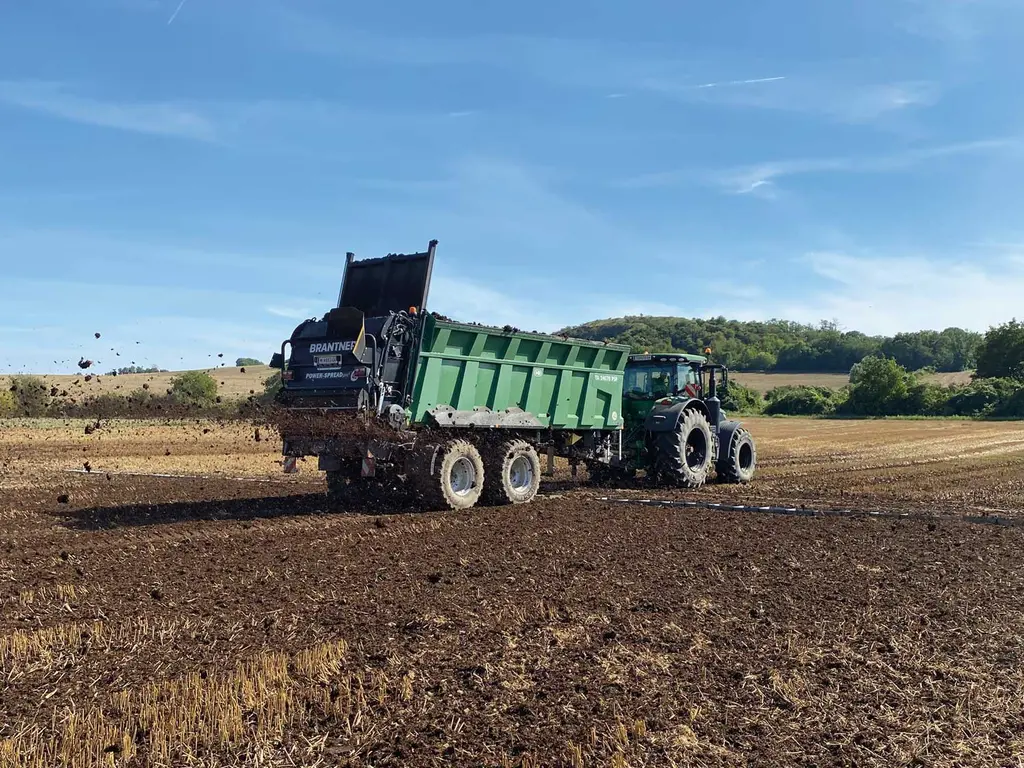Download print version
Test report 7041
The approval
A test mark „DLG-APPROVED for individual criteria“ is awarded for agricultural products which have successfully fulfilled a scope-reduced usability testing conducted by DLG according to independent and recognised evaluation criteria. The test is intended to highlight particular innovations and key criteria of the test object. The test may contain criteria from the DLG test scope for overall tests, or focus on other value-determining characteristics and properties of the test subject. The minimum requirements, test conditions and procedures as well as the evaluation bases of the test results will be specified in consultation with an expert group of DLG. They correspond to the recognised rules of technology, as well as scientific and agricultural knowledge and requirements. The successful testing is concluded with the publication of a test report, as well as the awarding of the test mark which is valid for five years from the date of awarding.
The test “Performance review in premium class” consists of testing agricultural tyres on tractors for their efficiency in different applications. Based on predefined traction force data, it was possible to determine the resultant speed on the field and the specific fuel consumption. The test was carried out in the same soil and slip conditions, so it was possible to assess specific fuel consumption relative to the traction force. Furthermore, the test included the inspection of the drive efficiency on the field for each tyre pair. That provided information about the tractive output on the field compared to the power take-off performance, which was determined by the DLG test bench beforehand. The measurements were made with the Continental “TractorMaster”, classified in the category standard tyre.
The tested tyre size: 600/70 R30 on the front axle (FA) and 710/70 R42 on the rear axle (RA). Details are given below in table 2. To get comparable measuring results, two additional tyre sets from two other premium tyre manufacturers were tested as references under the same conditions. The tyre pressure of each tyre was adjusted to the same level. On the front axle, the tyre pressure was 0.8 bar and on the rear axle 1.0 bar. Based on the criteria of the DLG transport test, the tyre pressure for the comparison on the road was set to 1.6 bar for each tyre.including evaluation by experienced users provided to be an essential element.
Assessment in brief
In the category “tyre efficiency”, the Continental TractorMaster was best in comparison to the references. The engine power of the test machine was transferred best under the test conditions. In another test area regarding fuel consumption under constant drive conditions, the Continental tyre also finished best with a slight lead over the references. This was due to low slippage losses of five to ten percent in the middle operational range. The conclusion is a better result for fuel consumption and higher ground coverage. The transport behavior on the road regarding the combination of hill and falt sections and the constructional maximum speed of 60 km/h is also good. The Continental TractorMaster is in second place in comparison to the references. But the results show that the tested tyres are set on a comparable level.
The product
Technical instructions and data can be found on the manufacturer’s website: https://www.continental-tires.com/specialty/agriculture
The method
At first, the tested tyre sets were installed on the test tractor. The test tractor was a Fendt 828 Vario for field applications and for transport tasks on the road. The load simulation was recorded with a braking tractor, a Fendt 933 Vario. For the transport task on the road, the test machine was loaded with a trailer. Every test tyre set had the same ballasting conditions.
For the test on the field, both tractors were connected by a steel cable with an integrated load cell. Furthermore, on the towing tractor, a Correvit-sensor was fitted to record the speed over ground data. The measurement of the wheel speed in combination with the rolling circumference was used to calculate slippage. Fuel consumption was also recorded with a volumetric measurement system. The test procedure was identical for every test tyre set.
The first part of the test showed the fuel consumption at constant driving speed and constant tractive load. The measurement was based on the load data of a field cultivator during stubble processing in a field. The second part of the test assessed the tyre efficiency with regard to the tractive output under soil conditions at the test location.
To get a basic comparative value of the engine power of the tractor, a PTO measurement on the DLG power take-off test bench was taken before the test activities on the field started. The soil conditions regarding humidity were recorded randomly for the whole test area during the tests.
Furthermore, fuel efficiency with regard to transport tasks on the road was calculated. The test setup was identical to the DLG PowerMix transport cycles. The test tractor ran a course of 36 km.
On this course, six parts with different gradients were used to measure the specific fuel consumption based on the adjusted speed caused by load conditions. The tractive load used was a trailer. It was connected with a load cell to the test tractor. The total weight of the trailer and the test tractor were the same in every test. Only the net weight of the tyres was slightly different. The second part of the DLG PowerMix transport test gave information about fuel consumption under driving conditions in a flat area with a maximum speed of 50 km/h or 60 km/h. Because of the low tractive load of the trailer, the rolling resistance of the tyres had a significant impact on the result.
The test results in detail
In the first part of the test with a constant load of 50kN, the specific fuel consumption was determined. See figure 4. The result shows that the fuel consumption of the Continental TractorMaster relative to the performance under the given test conditions is very good in comparison to the reference products.
The ground coverage (hectare per hour) was determined based on the edge conditions of the reference attachment, which provided the basis for the tractor adjustment. As reference attachment, a field cultivator with a working width and depth was used. The results are presented in figure 5.
Figure 5 shows the difference in the specific fuel consumption and the working efficiency per hour. The Continental TractorMaster works about 3% faster than the third placed reference set.
There is also an advantage to the second reference candidate of about 2.5%. That is also due to the different slip behaviours and therefore the resultant working speed.
Based on the ground coverage, a comparison between the fuel consumption and the farmed area is possible. The result is shown in figure 6. The overview also shows a slight advantage of the TractorMaster from Continental.
Figure 7 shows the tyre efficiency based on the engine/PTO power compared to the tractive output at constant speed. In comparison to the reference candidates, the Continental TractorMaster performed the best.
One reason for that is the contact patch of the tyre under the tested tyre pressure conditions. The determined tyre width before the test in table 2 also helped to categorize the result. The rear tyre played a major part in this positive result.
The performance of the test
tyre was also tested in transport tasks on the road. Therefore, the specific fuel consumption was measured under full-load conditions at different gradients on the hill sections and under part-load operation on flat sections at maximum speed.
The overall result is a combination of hill and flat sections with equal weighting. The difference in the resultant specific fuel consumption at 60 km/h and 50 km/h in the flat sections is essential. The different adjustments show the possible savings under flat conditions with reduced speed.
The results of the Continental TractorMaster in the transport mix at 50 km/h and in the mix at 60 km/h at the same level as the reference tyres. The performance here is similar to the class of premium standard tyres.
The tested combination of the Continental TractorMaster with dimensions 600/70 R30 on the front axle and 710/70 R42 on the rear axle showed a quite good performance in comparison with the reference tyres.
Regarding the performance during the simulated tractive load in a field, the results are even slightly better. Fuel consumption on average is around 2.5% to 3% lower than with the reference tyres. This offers an increased economic advantage over farmed areas.
The results also show that the Continental tyre had the best tyre efficiency factor with slightly more than 67%. One reason for that is that it had the biggest tyre width in the test and therefore the largest contact area in field conditions, especially on the rear axle. The results of the Continental TractorMaster in the DLG transport test show that the low slip level especially in the hill sections and the rolling resistance mainly in the flat sections have a major influence on the total result of that test. This puts standard Continental tyres into the premium class compared to the reference products.
Another optional but useful feature for the Continental TractorMaster is the ContiPressureCheck (CPC) system. It works with a sensor which is installed on the inner side of the tyre. This sensor delivers wireless data about the tyre during operation, such as pressure and temperature. You can find more information here: https://www.continental-tires.com/specialty/solutions/at-a-glance
Manufacturer and applicant
Scharmüller Gesellschaft m.b.H. & Co. KG
Doppelmühle 14,
4892 Fornach, Austria
Contact:
Telephone switchboard +43 (0)7682 6346-0
office@scharmueller.at
Test performed by
Testing agency
DLG TestService GmbH, Gross-Umstadt location, Germany
The tests are conducted on behalf of DLG e.V.
Department
Vehicle technology
DLG test framework
Emergency release system (status 2019)
Head of Department
Dipl-Ing (FH) Andreas Ai
Test engineer(s)
Dipl-Ing (FH) Andreas Ai*
*Author
Contact us
DLG TestService GmbH - Groß-Umstadt location • Max-Eyth-Weg 1 • 64823 Groß-Umstadt • Tel: +49 69 24 788-600 • tech@DLG.org














![[Translate to English:] Abbildung Continental TractorMaster Landwirtschaftreifen für Traktoren](/fileadmin/_processed_/1/5/csm_7041_18-779_Bild01_07cfa87da9.webp)









